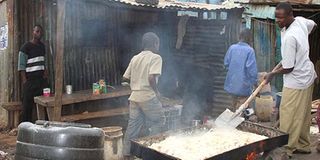Kenya MP pushes for legislation allowing traditional brew

A man prepares a brew in Mathare, Nairobi. MP Mututho has drafted the Alcoholic Beverage Control Bill 2009 which will regulate the contents of conventional beer and traditional brews. Photo/FILE
Naivasha MP John Mututho is pushing for legislation to legalise consumption of traditional brews.
Mr Mututho says criminalising traditional alcohol under Cap 70 and 121 of the Chang’aa Prohibition Act and Liquor Licensing Act had driven their preparation, sale and consumption underground, with disastrous consequences. “The alcohol is brewed in secrecy and no health standards are observed,” he says.
He says the ban on the sale and consumption of traditional brews has alienated a large number of Kenyans who would otherwise like to enjoy a sip of their traditional brew.
It is against this background that the lawmaker has drafted the Alcoholic Beverage Control Bill 2009 which, he says, will not only regulate the contents of conventional beer but also of traditional brews.
Too drunk
“I have so far spent over Sh1 million but that is peanuts when I look at the harm unregulated beer had done to our youths,” he says.
The Bill is ready and will be published in Parliament any time soon and, after 14 days, it will have its first reading.
“I am aware that the ban on local brews was driven by the belief that it rendered the youth too drunk to attend to care about matters. But that is what conventional liquor is also doing to them of late,” he says.
In Central Province, the lives of 50 per cent of the youth have gone to waste because of the liquor, says the MP, adding that this was why he wanted the content, packaging and accessibility of both traditional and conventional alcohol to be regulated.
“The poor should be able to enjoy a mug of busaa brewed in hygienic conditions without fear of arrest. Police and health workers should only check for compliance from brewers and distributors,” he says.
National Campaign Against Drug Abuse national coordinator Jennifer Kimani is incensed by the number of drunken youths roaming the villages as early as 10 am. She says the rate at which pubs are mushrooming is a cause for concern.
Five pubs
“On Thika Road, you can count more than five pubs in a radius of 500 metres, all with full parking lots. And unfortunately, drinking is no longer the preserve of men,” she says.
She is upset that most of the revellers are teenagers just out of high school.
“There are genuine health concerns which are not shared by industry players, especially the manufacturers,” she says.
According to research by the Kenya Medical Research Institute, alcohol abuse affects 70 per cent of families in Kenya, and this worrying trend could be the driving force behind the formulation of a comprehensive alcohol policy.
In November 2001, more than 140 people died and many others lost their eyesight after consuming an illegal ethanol-laced alcoholic brew.
In June 2005, 49 people died while more than 174 were admitted to hospital after drinking a home-made brew called “kwona mbee” (literally meaning “see the way ahead”), a concoction laced with methanol to give it a more potent kick.
Rough estimates say that the alcoholic beverages industry contributes Sh12 billion to the Kenyan economy. But Ms Kimani says most of this money goes towards treating people with alcohol-related ailments.
Road accidents
The government acknowledges that although alcohol consumption has existed since time immemorial and has some beneficial social and cultural effects, it also has disastrous health, social and economic implications that demand urgent attention by all industry players.
For instance, the increased number of road accidents are linked to drunken driving.
After insurance firms complained of huge losses because of the accidents, a commission of inquiry was set up in 1986-87 chaired by Justice Hancox and Dr Ooki Ombaka to look into the matter.
In 1996, a team of experts travelled to South Africa to study how that country was tackling the problem of traffic accidents.
Subsequently, the Traffic Bill was drafted in 1998 but was not debated by Parliament.
In 1990, a group of drunken boys invaded St Kizito Girls’ Secondary School, resulting in the deaths of 19 girls and the rape of many others.
Between 1998 and 2000, there was an upsurge in alcohol abuse-linked violence in secondary schools, particularly in Central Province. And Kenya is not staggering alone on the road to alcoholism.
Two billion
According to World Health Organisation estimates, two billion people worldwide consume alcoholic beverages and 76.3 million have been diagnosed with alcohol-related disorders.
These are among the reasons that compelled the government to establish Nacada in 2000 to coordinate a multisectoral response to alcohol and substance abuse.




